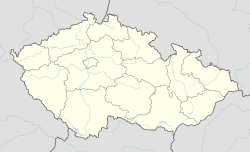Karwina
|
Karviná Karwina |
|||
|---|---|---|---|
| city | |||

Town square in Karviná-Fryštát
|
|||
|
|||
| Location in the Czech Republic | |||
| Coordinates: 49°51′15″N 18°32′34″E / 49.85417°N 18.54278°E | |||
| Country | Czech Republic | ||
| Region | Moravian-Silesian | ||
| District | Karviná | ||
| First mentioned | 1268 | ||
| Town rights | 1923 | ||
| City parts |
9
|
||
| Government | |||
| • Mayor | Tomáš Hanzel (ČSSD) | ||
| Area | |||
| • Total | 57.49 km2 (22.20 sq mi) | ||
| Elevation | 221 m (725 ft) | ||
| Population (2015) | |||
| • Total | 55,985 | ||
| • Density | 970/km2 (2,500/sq mi) | ||
| Postal code | 733 01 or 735 06 | ||
| Website | karvina.cz | ||
Karviná (Czech pronunciation: [ˈkarvɪnaː]; Polish: Karwina, Polish pronunciation: [karˈvina], German: Karwin) is a city in Moravian-Silesian Region of the Czech Republic, on the Olza River. It is administrative center of Karviná District. Karviná lies in the historical region of Cieszyn Silesia and is one of the most important coal mining centers in the Czech Republic. Together with neighboring towns it forms industrial Ostrava-Karviná Coal Basin.
It has 65,141 inhabitants (2001 census). 8.5% of the population are Slovaks and 8% of the population are Poles. Polish population is historically declining. In the past the town had a significant German community. There is also a growing Romani community.
Until the 19th century Karviná was a low importance village of Cieszyn Silesia, lying near the important town of Fryštát. Discovery of coal led to rapid urban development in Karviná and surrounding villages, and railways were soon built. After the split of Cieszyn Silesia in 1920 it became a part of Czechoslovakia as a main mining center of the country. In 1923 it gained city rights. In October 1938 was annexed by Poland, together with whole region known as Zaolzie and during World War II was a part of Nazi Germany. After the war it again became a part of Czechoslovakia. In 1948 Karviná, Fryštát and the surrounding villages of Darkov, Ráj and Staré Město were merged into one city named Karviná. The coat of arms of Fryštát was chosen as the coat of arms of Karviná and Fryštát became the historical center of this industrial city.
...
Wikipedia



